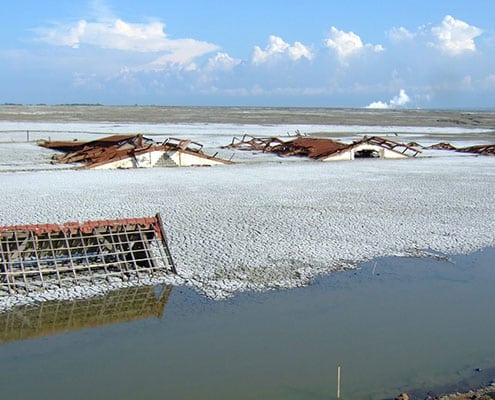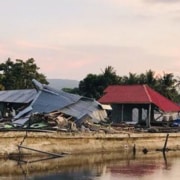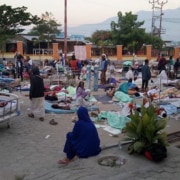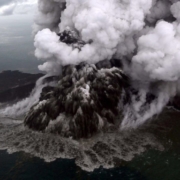
The remnants of a factory submerged by mud from the “Lusi” volcano, in 2010. Photo by Tim Mann.
Geological disasters, including volcanoes, earthquakes, landslides, and mudflows, have occurred on Earth for billions of years. They are widespread and fundamental geological processes that long pre-date human arrival on the planet, and are a natural consequence of plate tectonics and landscape evolution.
But the intensifying manner in which humans interact with our planet, including the injection of waste water into the Earth’s crust, drilling for oil and gas, constructing dams, mining, deforestation and land use change, and other activities, are increasing the anthropogenic influence on geologic processes. For example, Australia now exports more iron ore and coal on ships than natural processes export sediment to the ocean via rivers across the entire continent. Several recent earthquakes, changes in the heights of mountains, sinking of the land, landslides and other mass movements have been attributed to human activities. When natural disasters occur, it is important to assess and distinguish possible human from natural influences on their occurrence, severity, and extent.
On the morning of 29 May 2006, hot mud started erupting from the ground in the densely populated Porong subdistrict of Sidoarjo, East Java. The mud volcano was named Lusi, a portmanteau of the Indonesian word for mud, lumpur, and Sidoarjo. The Lusi mud volcano rapidly inundated villages in the area and in places the mud now reaches thicknesses of more than 17 metres. About 39,700 people have been displaced and costs associated with damage and disaster management are over US$2.7 billion.
More than a decade after it began, the origin of the Lusi volcano remains controversial. Some scientists suggest that it was naturally triggered by seismic waves originating from a magnitude 6.3 earthquake, which occurred two days before the eruption of Lusi, about 260 kilometres away in Yogyakarta. We know that earthquakes can cause hydrologic effects, including groundwater perturbations and liquefaction, at distances of tens to even thousands of kilometres away. The effect depends primarily on the magnitude and depth of the earthquake and the susceptibility of the sedimentary units to earthquake shaking and liquefaction. Shaking at the Lusi site from the Yogyakarta earthquake, however, would have been much lower than intensities typically thought to be required to initiate liquefaction and mudflow processes. The two-day delay between the earthquake and the Lusi eruption is difficult to explain using this model. And no anomalous behaviour in gas concentrations or compositions coming from the rocks beneath the volcano was observed. If present, this would have indicated the onset of liquefaction during the earthquake.
An alternative hypothesis is that drilling of a borehole, the “Banjar-Panji 1 gas exploration well”, located just 150 metres from what became the main vent of the Lusi mud volcano, triggered what is called an internal blowout because of a surge in fluid pressures in the well hole. The well was “uncased” at depths of 1 to 2.8 kilometres, meaning that it was open to fluid exchange with water-rich sediments in the subsurface. Several problems, including smaller blowouts, occurred during drilling of the well and before the Lusi eruption. A major fluid influx, or kick, into the BJP-1 well, is considered by many experts to be the trigger for the Lusi eruption. The mud and fluids may have reached the surface via a fracture in the rock connecting the vent for the Lusi volcano to the drill hole.
On balance, the majority of evidence suggests that the Lusi eruption was not triggered naturally but was instead caused by the drilling operations. The actual location of the vent may relate to natural geological heterogeneities, but the initiation and severity of the mud volcano are likely to have a human origin.
Lusi continues to provide a poignant reminder of our fragile co-existence with a complex planet, and remind us of how anthropogenic activities can have severe, albeit unintended, consequences.
Two videos by artist Susan Norrie about the aftermath of the 2006 Sidoarjo mud volcano are being exhibited at the University of Melbourne’s Ian Potter Museum of Art until 3 July.








